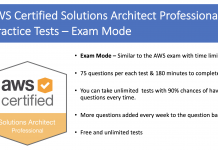You have an application that is generating a log file every 5 minutes and you need to store these log files appropriately. The requirements for storing the log files are:
- They should be quickly retrievable when needed, as they may be required only for verification in case of some major issue.
- The logs will need to be accessed frequently, as all log data is retrieved and compiled from the files into a bi-monthly report.
- The logs are essential to quarterly audits, so the storage solution must offer a high level of durability.
- Cost should also be minimized for the storage service as much as possible.
Which of the storage options below is the best choice to meet these requirements?
Explanation
Amazon S3 stores objects according to their storage class. There are technically four major storage classes: Standard, Standard – Infrequent Access, Reduced Redundancy Storage (RRS) and Glacier.
Standard is for Amazon S3 and provides very high durability. Standard – Infrequent Access is designed for with a minimum data amount required and paid storage for at least 30 days. Glacier is for archival and the files are not available over the internet. Reduced Redundancy Storage is for less critical files.
S3 OneZone IA is a variation of Standard-IA, which offers data archival at a reduced price, but also with less durability because the data within this class is stored within a single availability zone rather than spread throughout all availability zones within the S3 buckets region, as it is with S3 Standard storage.
Explanation
Amazon S3 stores objects according to their storage class. There are technically four major storage classes: Standard, Standard – Infrequent Access, Reduced Redundancy Storage (RRS) and Glacier.
Standard is for Amazon S3 and provides very high durability. Standard – Infrequent Access is designed for with a minimum data amount required and paid storage for at least 30 days. Glacier is for archival and the files are not available over the internet. Reduced Redundancy Storage is for less critical files.
S3 OneZone IA is a variation of Standard-IA, which offers data archival at a reduced price, but also with less durability because the data within this class is stored within a single availability zone rather than spread throughout all availability zones within the S3 buckets region, as it is with S3 Standard storage.



